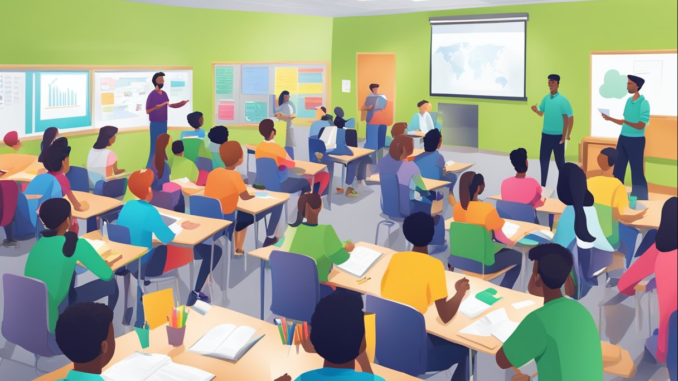
10 Innovative Teaching Strategies to Boost Student Engagement in 2025
In recent years, the landscape of education has undergone a dramatic transformation, driven largely by technological advancements, evolving student needs, and the changing nature of the workforce. As we look ahead to 2025, educators are finding innovative ways to enhance student engagement in the classroom, ensuring that learning is not only effective but also exciting and meaningful. Here are 10 strategies that are revolutionizing how students learn and participate in the educational process.
1. Gamification of Learning
Gamification involves incorporating game elements like points, badges, and leaderboards into the learning process. This strategy taps into students’ competitive nature and love for challenges, making education more fun and interactive. Tools like Kahoot!, Quizlet Live, and Classcraft allow teachers to design engaging quizzes and activities that encourage collaboration and friendly competition, enhancing student engagement.
2. Project-Based Learning (PBL)
Project-Based Learning is a student-centered pedagogy where students learn by actively engaging in real-world and meaningful projects. PBL allows students to work on long-term projects that are both intellectually challenging and relevant to their lives. This hands-on approach fosters critical thinking, problem-solving, and creativity, while promoting deeper learning and sustained engagement.
3. Flipped Classroom
In a flipped classroom, students are introduced to new content at home through videos, podcasts, or reading materials. Classroom time is then dedicated to applying and discussing the concepts in a collaborative environment. This method allows teachers to provide more personalized guidance, while students can learn at their own pace. The flipped classroom fosters active participation and better retention of knowledge.
4. Personalized Learning
With personalized learning, educators tailor their teaching strategies to meet the unique needs, strengths, and interests of each student. Technology plays a significant role here, as adaptive learning platforms and AI-driven tools can track individual progress and suggest customized learning paths. Personalized learning helps students feel valued, as they are given the opportunity to learn in a way that suits their learning style.
5. Collaborative Learning with Technology
Collaborative learning leverages technology to enable students to work together on projects and assignments, even if they are not physically in the same room. Tools like Google Workspace, Microsoft Teams, and Padlet allow students to collaborate in real-time, exchange ideas, and create projects that reflect collective intelligence. This fosters teamwork, communication, and problem-solving skills.
6. Interactive Virtual Reality (VR) and Augmented Reality (AR)
Virtual and Augmented Reality technologies have become increasingly accessible and are offering new ways to bring lessons to life. VR allows students to immerse themselves in different environments, such as ancient civilizations or outer space, while AR can overlay digital content onto the physical world. These technologies make abstract concepts more tangible and create a highly engaging, experiential learning environment.
7. Social-Emotional Learning (SEL) Integration
Incorporating Social-Emotional Learning into the curriculum helps students develop essential skills such as empathy, self-regulation, and emotional intelligence. Teachers can integrate SEL activities through role-playing, group discussions, and mindfulness practices, fostering a positive learning atmosphere and helping students build strong interpersonal relationships, which in turn increases engagement.
8. Peer Teaching and Mentorship
Peer teaching allows students to take on the role of educators, helping their classmates understand complex concepts. This strategy boosts confidence, reinforces learning, and promotes collaboration. Mentorship programs, where older students guide younger ones, further enhance engagement by creating a sense of community and shared responsibility for learning outcomes.
9. Interactive and Dynamic Assessment Methods
Traditional tests and quizzes can often lead to disengagement, but interactive assessments are gaining popularity. Methods like formative assessments, digital portfolios, and peer reviews provide students with ongoing feedback and opportunities for improvement. Interactive quizzes, open-ended questions, and real-world case studies engage students more actively, encouraging them to apply their knowledge in meaningful ways.
10. Incorporating Student Voice and Choice
One of the most powerful ways to increase engagement is by giving students a voice in their learning process. Allowing students to choose the topics they study, how they demonstrate their learning, or the format of assignments fosters ownership of their education. When students feel they have a say in what and how they learn, they are more likely to stay engaged and motivated.
Conclusion
As we move toward 2025, the key to boosting student engagement lies in embracing innovative and adaptive teaching strategies that cater to the diverse needs of modern learners. By integrating technology, personalization, and active learning experiences into the classroom, educators can create a dynamic learning environment that sparks curiosity, collaboration, and passion for learning. These strategies not only improve engagement but also prepare students for the challenges of the future, equipping them with the skills they need to succeed in a rapidly changing world.
